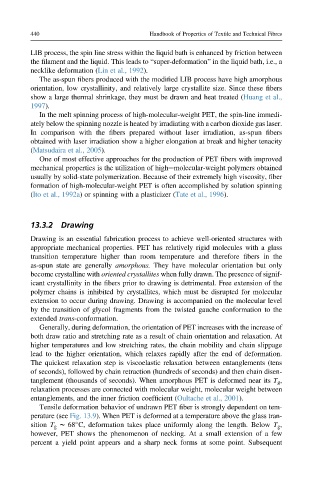Page 467 - Handbook of Properties of Textile and Technical Fibres
P. 467
440 Handbook of Properties of Textile and Technical Fibres
LIB process, the spin line stress within the liquid bath is enhanced by friction between
the filament and the liquid. This leads to “super-deformation” in the liquid bath, i.e., a
necklike deformation (Lin et al., 1992).
The as-spun fibers produced with the modified LIB process have high amorphous
orientation, low crystallinity, and relatively large crystallite size. Since these fibers
show a large thermal shrinkage, they must be drawn and heat treated (Huang et al.,
1997).
In the melt spinning process of high-molecular-weight PET, the spin-line immedi-
ately below the spinning nozzle is heated by irradiating with a carbon dioxide gas laser.
In comparison with the fibers prepared without laser irradiation, as-spun fibers
obtained with laser irradiation show a higher elongation at break and higher tenacity
(Matsudaira et al., 2005).
One of most effective approaches for the production of PET fibers with improved
mechanical properties is the utilization of highemolecular-weight polymers obtained
usually by solid-state polymerization. Because of their extremely high viscosity, fiber
formation of high-molecular-weight PET is often accomplished by solution spinning
(Ito et al., 1992a) or spinning with a plasticizer (Tate et al., 1996).
13.3.2 Drawing
Drawing is an essential fabrication process to achieve well-oriented structures with
appropriate mechanical properties. PET has relatively rigid molecules with a glass
transition temperature higher than room temperature and therefore fibers in the
as-spun state are generally amorphous. They have molecular orientation but only
become crystalline with oriented crystallites when fully drawn. The presence of signif-
icant crystallinity in the fibers prior to drawing is detrimental. Free extension of the
polymer chains is inhibited by crystallites, which must be disrupted for molecular
extension to occur during drawing. Drawing is accompanied on the molecular level
by the transition of glycol fragments from the twisted gauche conformation to the
extended trans-conformation.
Generally, during deformation, the orientation of PET increases with the increase of
both draw ratio and stretching rate as a result of chain orientation and relaxation. At
higher temperatures and low stretching rates, the chain mobility and chain slippage
lead to the higher orientation, which relaxes rapidly after the end of deformation.
The quickest relaxation step is viscoelastic relaxation between entanglements (tens
of seconds), followed by chain retraction (hundreds of seconds) and then chain disen-
tanglement (thousands of seconds). When amorphous PET is deformed near its T g ,
relaxation processes are connected with molecular weight, molecular weight between
entanglements, and the inner friction coefficient (Oultache et al., 2001).
Tensile deformation behavior of undrawn PET fiber is strongly dependent on tem-
perature (see Fig. 13.9). When PET is deformed at a temperature above the glass tran-
sition T g w 68 C, deformation takes place uniformly along the length. Below T g ,
however, PET shows the phenomenon of necking. At a small extension of a few
percent a yield point appears and a sharp neck forms at some point. Subsequent

